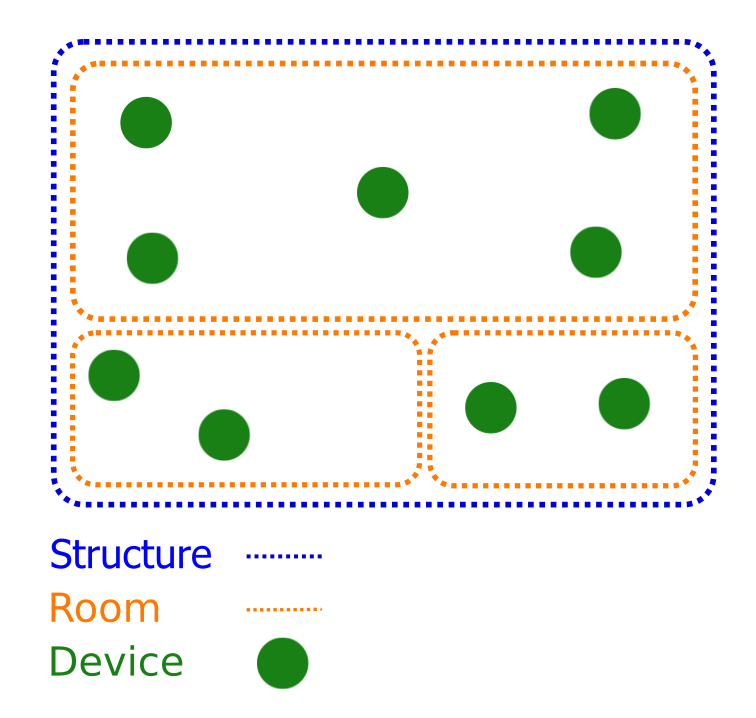Działania w inteligentnym domu opierają się na Google Home Graph – bazie danych, która przechowuje i dostarcza dane kontekstowe o domu i jego urządzeniach. Baza danych Home Graph przechowuje informacje o budynkach (np. domu lub biurze), pomieszczeniach (np. sypialni lub salonie) i urządzeniach (np. głośniku i żarówki). Na przykład Home Graph może zapisywać informacje o domu z salonem zawierającym wiele rodzajów urządzeń różnych producentów, takich jak światło, telewizor i głośnik. Ta informacja jest dostępna dla Google Assistant, aby umożliwić wykonywanie żądań użytkowników na podstawie odpowiedniego kontekstu. Dane o stanie, na przykład informacje o włączeniu żarówki, nie są przechowywane przez długi czas – są tymczasowe i są używane tylko w Home Graph.
Home Graph to logiczna mapa Twojego domu. Dzięki temu możesz w naturalny sposób rozmawiać z użytkowniczką Assistant. Jeśli siedzisz w lozie i chcesz wyłączyć światło w lozie, powiedz po prostu OK Google, wyłącz światło i nie wspominaj o pokoju, w którym obecnie jesteś.
Zalety Home Graph:
- Polecenia niejawne. Ty, urządzenie Google Home i Twoje światła jesteście w tym samym pomieszczeniu. Wystarczy, że włączysz światło. Nie musisz określać, w którym pomieszczeniu znajdują się światła.
- Większa kontrola nad kierowaniem bezpośrednim. Będąc w innym pomieszczeniu, możesz wyłączyć światła w kuchni, nawet jeśli źródła pochodzą od różnych producentów. Intencja smart home jest określana dla konkretnego pokoju wskazanego w zasadzie Home Graph.
Konstrukcje
Google Home app (GHA) umożliwia użytkownikowi konfigurowanie wielu domów, co pozwala mu zarządzać wieloma domami. Każda obiekt ma własny zestaw sal i urządzeń. Struktura składa się z tych elementów:
- Menedżerowie – konto właściciela lub właścicieli obiektu. Każda struktura musi mieć co najmniej jednego menedżera. Po zdefiniowaniu menedżera może on udostępnić strukturę innym użytkownikom i cofnąć jej udostępnianie.
- Pokoje – pokoje, które są częścią budowli.
- Etykiety — etykieta określająca strukturę, na przykład „Dom Jana”.
- Urządzenia – urządzenia, które są częścią domu. Mogą to być urządzenia różnych producentów.
Rysunek 1 przedstawia przykładowy dom z budynkiem, 3 pomieszczeniami i kilkoma urządzeniami:

Pokoje
Pokój należy do budynku i składa się z tych elementów:
- Etykiety – etykieta identyfikująca pokój, na przykład „Główna sypialnia”.
- Urządzenia – urządzenia znajdujące się w pomieszczeniu. Mogą to być urządzenia różnych producentów.
Urządzenia
Urządzenie musi należeć do co najmniej 1 obiektu, może należeć do maksymalnie 1 pomieszczenia i ma te właściwości:
- Typ – typ urządzenia, np. lampa, aparat lub urządzenie klimatyzacyjne.
- Cechy – rodzaj cech obsługiwanych przez urządzenie. Każde urządzenie może mieć
różne cechy. Światło może mieć takie cechy jak
BrightnessiColorSetting.
Cechy
Cechy mają te właściwości:
- Atrybuty – statyczne atrybuty urządzenia. Może to być na przykład jednostka temperatury lub tryb.
- Stan – stan urządzenia. Lampa może zwrócić stan jasności, aby wskazać aktualną jasność tej konkretnej lampy. Każda cecha urządzenia dodaje inny stan urządzenia.
- Etykiety – etykieta identyfikująca urządzenie, na przykład „Lampa do sypialni”.

